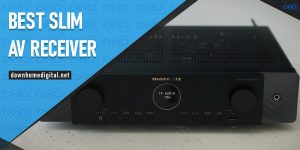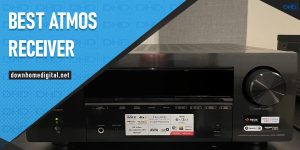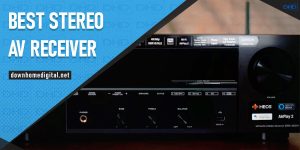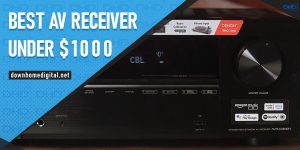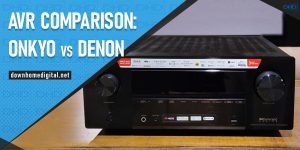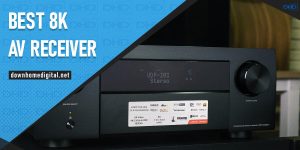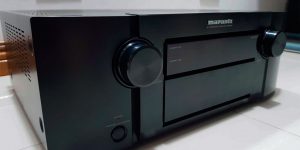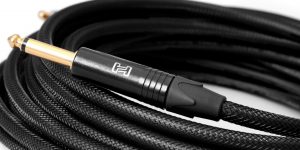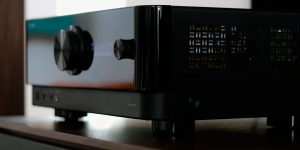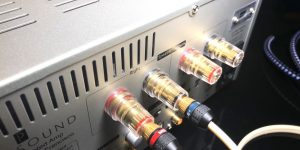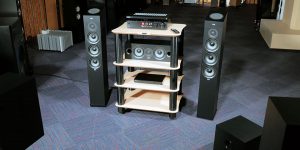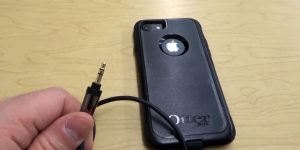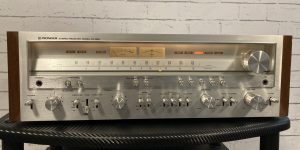The Japanese company Pioneer has been creating media equipment since 1938. Since that time, they have been able to gain many fans thanks to the exceptional quality of products and adherence to traditions that have helped to maintain this quality to the present day.
Today, Pioneer offers a variety of receivers in its extensive line of Elite VSX and Elite SC models. It is with these devices that you lay the foundation for your personal home theater experience with glorious sound and many practical features. In order to choose the really best Pioneer receiver of these series, I have created a review in which I will reveal the strengths and weaknesses of each model. After studying the material in my article, you will be able to make an informed choice of the right device for you.
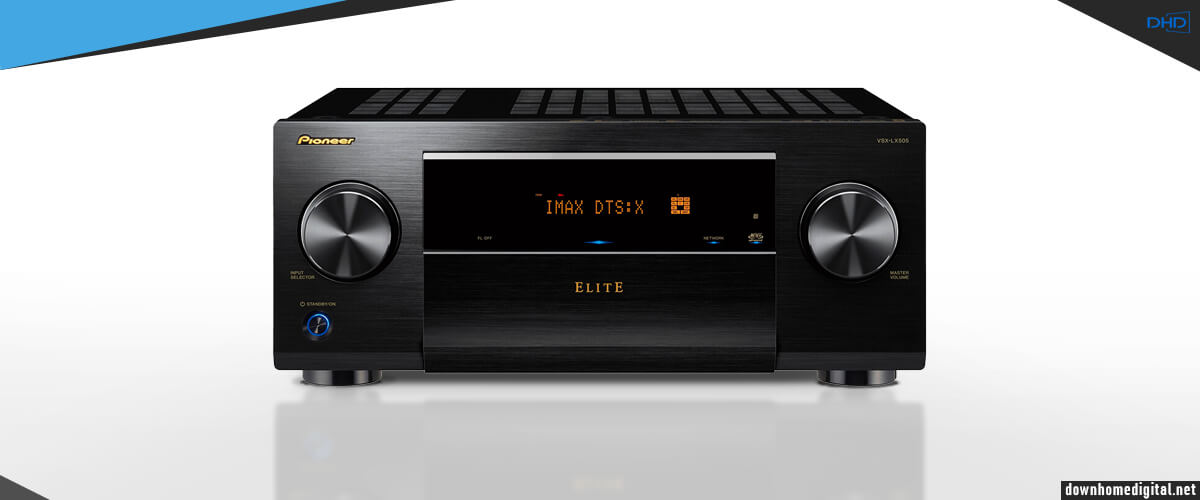
Pioneer receiver comparison table
| Name | Channels | Power output | HDMI in/out | Bluetooth/Wi-Fi | Review |
|---|---|---|---|---|---|
| Pioneer Elite VSX-LX505 best overall | 9.2 | 120W/8 Ohm | 7/2 | yes/yes | Review |
| Pioneer Elite VSX-LX105 under $1000 | 7.2 | 100W/8 Ohm | 6/2 | yes/yes | Review |
| Pioneer Elite VSX-LX805 premium | 11.4 | 150W/8 Ohm | 7/2 | yes/yes | Review |
| Pioneer SX-10AE stereo | 2.0 | 45W/8 Ohm | 0/0 | yes/no | Review |
Difference between home theater and stereo receivers
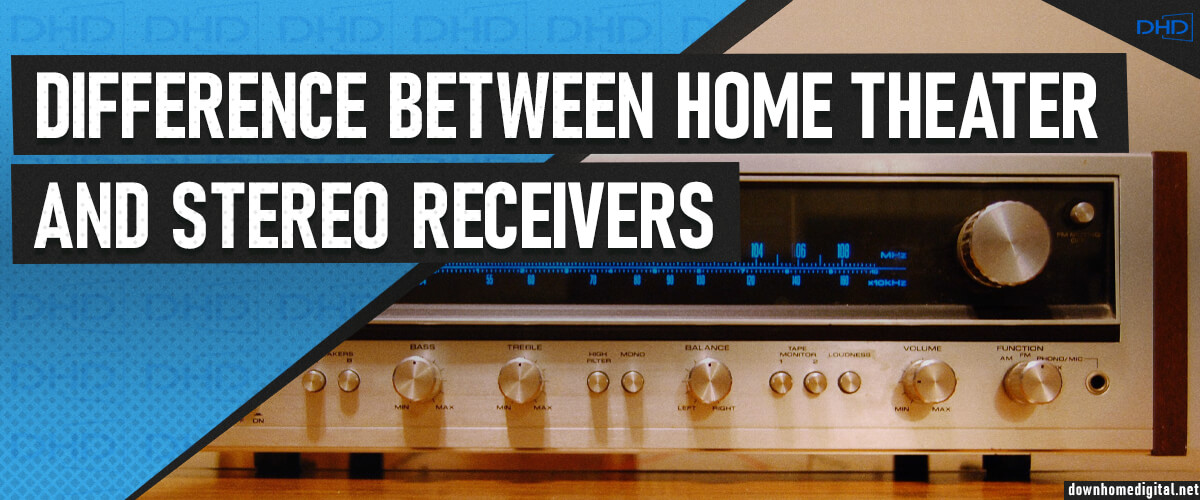
And as part of my Pioneer receivers review, I first want to discuss the difference between an AV receiver and a stereo receiver. Newcomers often do not see the difference and may mistakenly buy the wrong device. That’s why I’ll take a closer look at this issue.
Unlike AV receivers, a stereo receiver is less complicated to operate. First, because of the number of channels (there are only 2), and second, because of its limited features. It is used mainly for listening to different music content.
The AV receiver is much superior to its stereo competitor. You can connect many devices (TV, Blu-ray player, game console, etc.) to it via different interfaces and use it as the main link in a home multimedia system. The AV receiver also clearly benefits from the potential of multi-room applications and network capabilities.
Many stereo receivers are equipped with Bluetooth for wireless streaming. Digital audio broadcasting, or DAB for short, is also possible. However, these options are limited to only two channels.
And finally, if the choice has become between these two types of devices, then be guided by your needs. If it’s just listening to music, then a stereo receiver is worth considering. And if you are planning a full-fledged home theater with surround sound, then the AV receiver is the right choice.
How I picked and tested Pioneer receivers
I tested the presented receivers in the proven way. It includes watching a movie on Blu-ray and a music test. This time I chose John Wick: Chapter 3 – Parabellum so that I could appreciate all the charms of the film: the shootings, the chases, the soundtracks, and, of course, the dialogues.
And also selected the most interesting compositions from my audio library:
- Radiohead – The National Anthem – Spotify
- Bob Marley & The Wailers – Turn Your Lights Down Low – Deezer
- Arctic Monkeys – Do I Wanna Know – SoundCloud
- Led Zeppelin – Ramble On (CD player)
- The Weeknd – The Hills (CD player)
- Jacky Terrasson – Reach (CD player)
- Mark Nauseef – With Space in Mind (CD player)
- Mahler – Symphony No.2 (CD player)
The following equipment became the testing setup to help to choose the top Pioneer receiver:
- CD player SACD 30n
- Blu-ray player Sony UBP-X700
- Speaker wire – AudioQuest Type-9
- Speakers for movie – Klipsch RP-8060FA
- Stereo speakers:
- Klipsch Reference R-26FA
- KEF Q350
- DALI OBERON 5
Pioneer home theater receiver reviews
Pioneer Elite VSX-LX505 – best overall

I want to start my review with the Pioneer Elite VSX-LX505. The model rightfully occupies the first place on my chart, as it is the optimal value-for-money option among all the ones presented in the review. Released in 2022, the AVR is a modern device with 9.2 amplification channels and state-of-the-art features priced within the mid-range segment.
The level of quality can be felt even in the receiver’s design. Since VSX-LX505 belongs to the Elite lineup, the manufacturer paid much attention to this point. The internal components are good, although what is there to be surprised about when it is the next after the flagship Pioneer Elite VSX-LX805? Of course, the receiver under consideration is inferior to the latter and costs twice as cheap, but still, its quality is quite trustworthy. The LCD screen is large, bright, and perfectly viewable. Regulators also caused positive emotions, but for the price category of the model, it should be so.
The receiver operates in 11.2-mode, with the help of which you can manage the configuration 7.2.4. However, you can not control the two subwoofers separately. The VSX-LX505 has nine power amplifiers, which, depending on the configuration, can also be used for dynamic sound in two adjacent rooms. In addition, it can passively supply the third listening area with audio signals via the pre-outs.
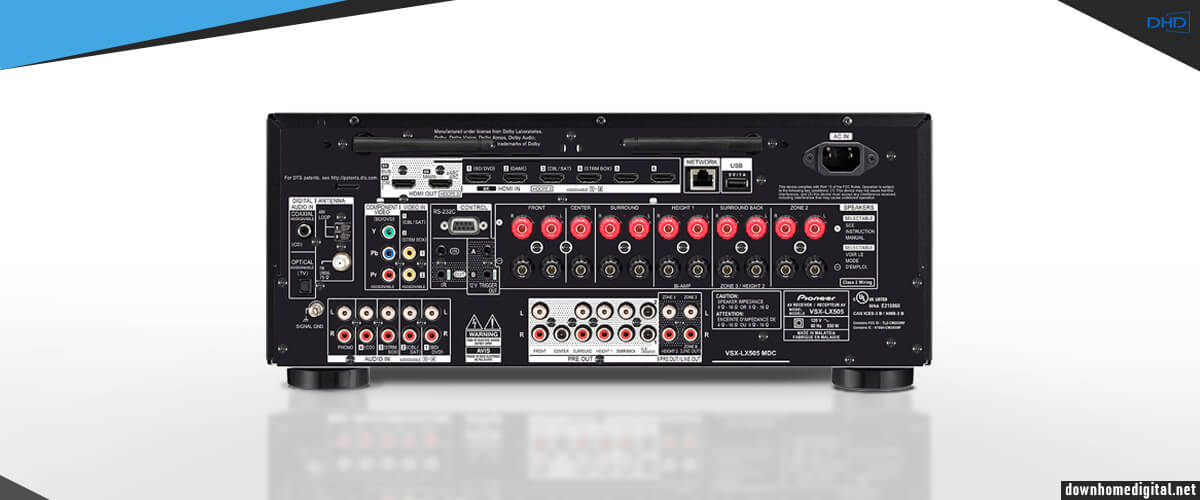
As usual for this class of receivers, there are Dolby Atmos and DTS: X audio decoders and their Dolby Surround and DTS Neural: X upmixers. However, I draw your attention to the fact that there is no cross-format upmixing.
The receiver “communicates” with the outer world via AirPlay2, Bluetooth, and some other wireless transmission technologies. I also want to say that Spotify, Deezer, Tidal, and Amazon Music have been integrated.
There is also a well-equipped video path. This 8K receiver is equipped with a video card with 2 HDMI outputs and 7 HDMI inputs compatible with 4K/120p, 8K/60p and HDR10+, Dolby Vision, and HLG standards. In addition, there is an upscale function that only converts 1080p signals to 8K resolution. In this aspect, the VSX-LX505 is slightly inferior to the VSX-LX805 with 1 less HDMI output.

Before testing, I used an automatic setup. It gave the midrange a little more detail and brightness. In the music test, the VSX-LX505 delighted me with detailed and transparent sound, without harshness. I loved the instrumental music because of the clean, crisp, and powerful sound style of the LX505.
I left Phase Control active. It added a little more boost and clarity to the bass reproduction. In addition, I have noticed that the LX505 differs from the LX104: new is the Dialog Enhancer function to improve audio quality, which, however, is achieved through speech reproduction separation.While watching the film O Troll da Montanha, I paid particular attention to the dialogue and was not disappointed. The voices, intonation, and tone conveyed all the emotions and moods of the characters despite the noisy background, and I didn’t have to constantly adjust the volume to hear them.
The Atmos surround sound test was also successful. I felt a powerful bass exactly where I expected it. The effects were elastically separated from the speakers and opened up broad dynamic sound fields.
By the way, I tried a few speakers, as I always do, and I especially liked the rather ordinary (in the sense of specificity) sound of VSX-LX505 with a pair of Klipsch Reference R-26FA front speakers. I basically respect the brand’s products; in my opinion, their speakers are quite well combined with many receivers of different categories. But in this particular case, the receiver’s potential opened up and played with new colors, and in stereo, I could hear details that I couldn’t hear with other sets.
The Pioneer Elite VSX-LX505 is a well-balanced, modern device of excellent quality. It is inferior to the premium VSX-LX805 in power, the number of HDMI ports (only 1 less output, the quality of internal components, and the number of channels (although it can expand to an 11-channel system with an external amplifier, but there are only 2 subs and the system sees them as a single unit).
But do you really need all these benefits to pay not just a couple hundred extra bucks for them but almost twice as much? The Elite VSX-LX505 has plenty of everything. It supports the most advanced 8K video capabilities, will satisfy gamers, supports most of the important advanced surround sound formats, and has quality wireless connectivity for listening to streaming services and using voice assistants. I’m all for having good tech, and in my mind, this receiver is more than good. The honorable first place is well deserved.
| Power |
|
| HDMI features |
|
| Video features |
|
| Network |
|
| Surround sound processing |
|
Pros
- Optimal price/performance ratio for this selection.
- Ability to expand the system from 9.2 to 11.2.
- Preamplifier outputs for all channels.
- Lively and detailed sound.
- Advanced and efficient auto-calibration system.
- Clear wireless signal reproduction.
Cons
- 2 subs are treated as 1 by the system.
- No cross-format upmixing.
Pioneer Elite VSX-LX105 – top model under $1000
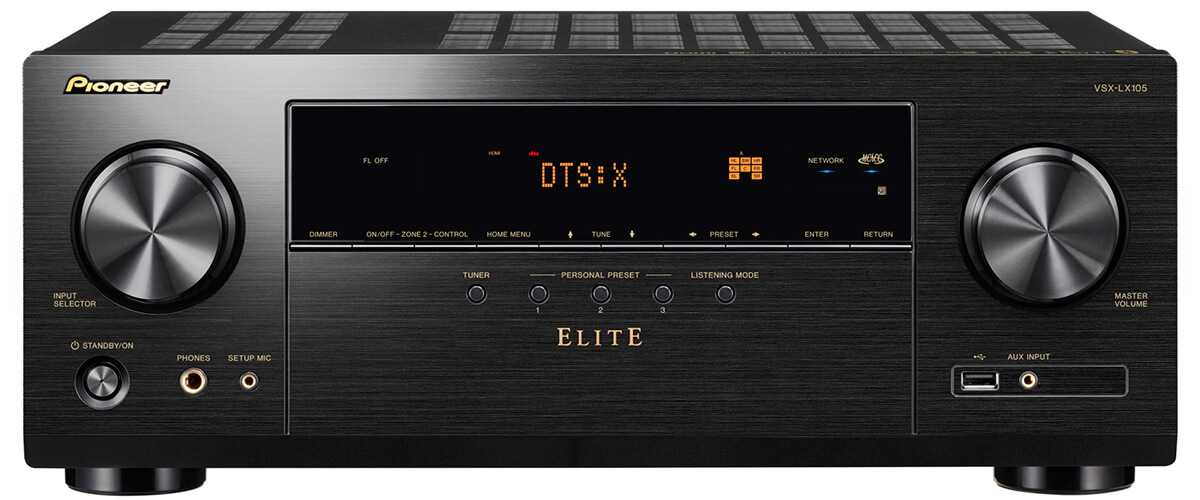
Next, consider the younger model from the Elite series. The Pioneer VSX-LX105 is a 7.2 channel model delivering up to 100W / 8 ohms per channel. You’ll pay up to $1000 for it, and it’s inferior to the leader of the selection, but it’s hard to call this receiver a budget receiver.
Since AVR belongs to the Elite series, where all models look almost like twin brothers, there’s almost nothing to discuss. But the VSX-LX105 has no bass and treble controls, which is disappointing. They are on the remote control, but I usually trust them less than the controls on the panel. Besides, this option doesn’t save much in this case because the remote control doesn’t cope with tuning as detailed as in more expensive models. But the construction is generally not flimsy; Pioneer creates reliable receivers in any price category.
VSX-LX105 has most of the multichannel audio formats available, such as DTS: X, Dolby Atmos, Dolby Atmos Height Virtualization with the unique Dialog Enhancement advanced music features. And for even more immersion, the unit features pre-outs to link it to an external, more powerful amplifier to create a 5.2.2-channel home theater system.
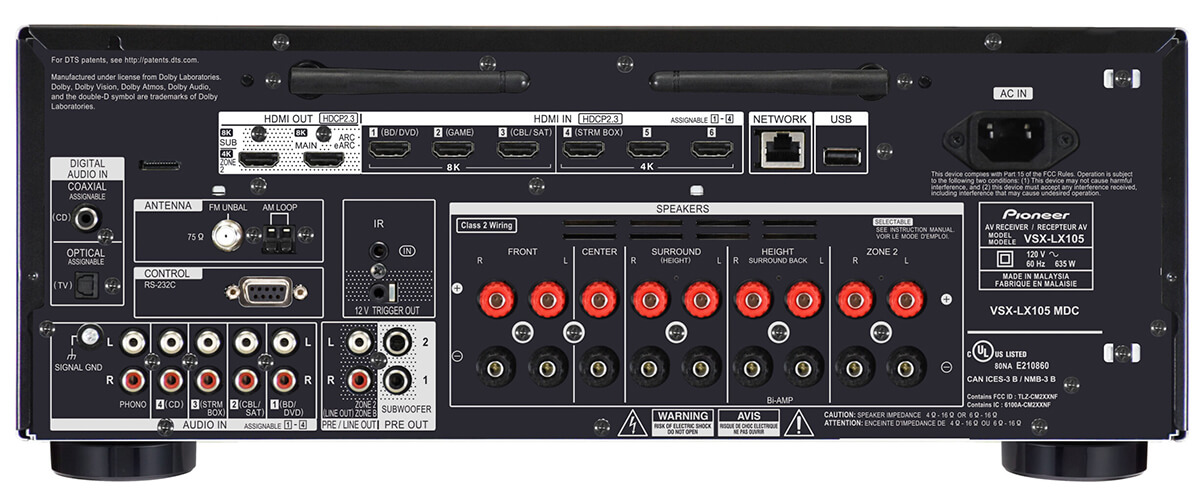
For Internet connectivity, the Pioneer VSX-LX105 has standard Ethernet and dual-band Wi-Fi. However, the network section is not limited to this. In VSX-LX105, I found many great options aimed at broadcasting content – DTS Play-Fi, Flare Connect, Bluetooth, AirPlay2. Plus, it has integrated streaming services like Amazon Music, Spotify, TIDAL, and Deezer.
In terms of image, the Pioneer VSX-LX105 is compatible with all video streams up to 8K and 120fps. It also supports HDR10+, HLG, and Dolby Vision to display high-contrast images with a wide color gamut. I was also able to up-scaling from 1080p to 4K with no problems. From 1080p to 8K, the receiver scales worse. The picture, in general, is not bad, but when watching a movie, pixel popping, freezes, and sounds out of sync with the image started so that I wouldn’t use it.
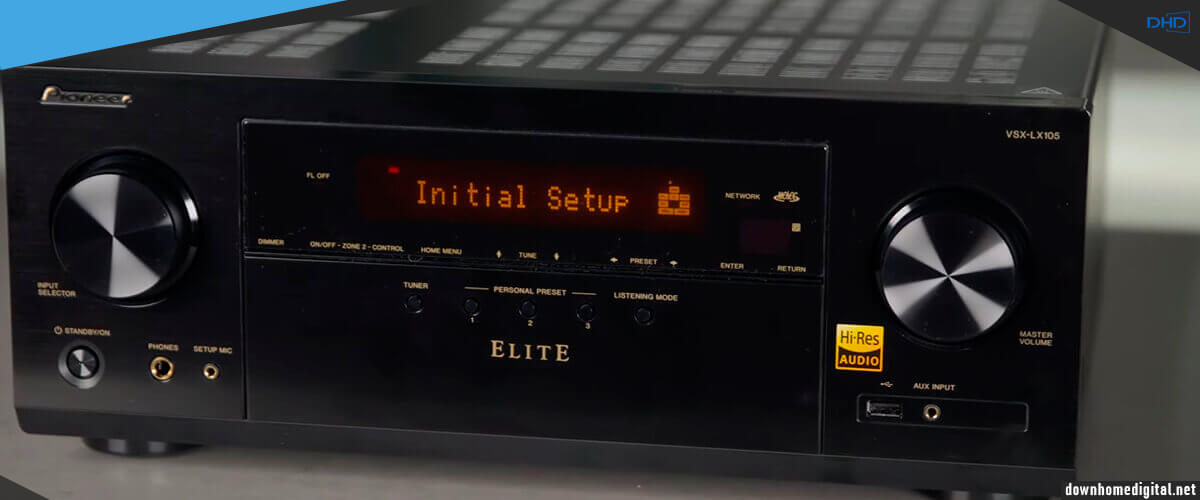
I decided to start my test using presets. The first observation on this point is that filtering is quite limited, as is the cutoff frequency. There is no LFE adjustment. The last auto-calibration I got was a refocused sound stage, but no loss of scale. This affects the operation of all formats, all Dolby formats up to Atmos and all DTS formats up to IMAX Enhanced. And when watching the movie, I got an accurate reflection of the dialogues. As for surround effects, they are reflected in all directions. I felt at the center of the action. The LX105 effortlessly recreates a tangible ambiance without putting pressure on the surroundings. I won’t say that with this you don’t need to pay attention to more expensive models. Sure, the overall soundstage is simpler and flatter compared to the sound of the VSX-LX505, but for its category, it’s very good.
I listened to the music in stereo, with no subwoofer or effects, to get an idea of its versatility between film and music. The LX105 creates a pleasing sound stage with stressed vocals and exciting depth. Bass hold can be more precise.
The Pioneer Elite VSX-LX105 receiver can keep you entertained for years, provided you’re sure to be satisfied with a 7-channel system with no expansion options. The variety of multi-channel and network audio playback makes it a self-sufficient device, with enough power even for a large room (the nominal figure is only slightly inferior to the leader of the selection, VSX-LX505). In addition, this receiver lets you enjoy 8K video and scales well to 4K.
Despite the flaws, quite expected in this price category, its construction is quite reliable. And if you’re not picky about sound details, as the overall picture is simple and uncomplicated, the Elite VSX-LX105 is well worthy of the title of the best Pioneer receiver under $1000.
| Power |
|
| HDMI features |
|
| Video features |
|
| Network |
|
| Surround sound processing |
|
Pros
- Solid construction for a receiver under $1000.
- Good power for an inexpensive receiver.
- With soundstage refocusing, I achieved excellent movie dialogue transfer.
- A good set of wireless technologies.
Cons
- No ability to adjust bass and treble in detail.
- The remote control is limited in settings.
- Lack of subwoofer control.
- Can’t handle up to 8K upscaling; problems are observed.
Pioneer Elite VSX-LX805 – premium

The most expensive, most powerful Pioneer home theater receiver in my review is the flagship of the Elite lineup, the VSX-LX805. It offers 11 full channels of amplification with the ability to add 4 subwoofers. You get 150 watts per channel at 8 ohms. And here I’ll mention right away that it’s compatible with all multi-channel audio formats, including Dolby Atmos and DTS: X. It also has two precision 32-bit ESS DACs of audiophile class, all new symmetric Class AB amplifier, PQLD and PQFA technologies, designed to eliminate jitter, which I obviously did not notice in Pioneer Elite VSX-LX505.
Everything about this receiver says it’s premium. Yes, it looks similar to the other models in the lineup, but if you’re into quality materials, you can just see it with the naked eye. I like the orange backlighting of the large LCD and the blue backlighting of the Standby/On button. When I touched the volume control, I said to myself, “Aha,” because it’s as smooth and sensitive as it should be in really expensive models. I flipped the receiver over to plug it in and was finally convinced of the quality of every part. All the connectors are neatly arranged so everything is well accessible (even though you won’t use this factor very often). There are even XLR connectors here. All in all, everything is for elite connectivity and the highest quality signal transfer from your sources.

The receiver’s video capabilities are very similar to the VSX-LX505. The receiver has 7/3 HDMI connectors (the rating leader has 7/2), 6 of 7 inputs have version 2.1 for video with 8K resolution, HDCP 2.3 protection, CEC, and support functionality for avid gamers. The outputs have an eARC interface. Actually, these are the highest performances you can expect today. And I didn’t notice any issues with any signal transmission. Even the 8K scaling was very close to the original. Everything is top-notch.
The networking capabilities of this Pioneer AV receiver seem limitless. There are integrated streaming services and voice assistants, but also DTS Play-Fi, AirPlay 2, and Chromecast for multi-room audio. Bluetooth supports all existing codecs (SBC, AAC, aptX, aptX HD). Needless to say, my coworkers stopped by the studio where I was testing music after hearing it from my speakers to see which model I was currently researching. As a whole company, we gave a fat plus to this unit, even though we usually have other brands in our favorites.
When I prepare a system for surround sound testing, I always start with calibration. And Pioneer is challenging, as I’m not too fond of the MCACC brand development. This receiver has the PRO version installed, but it performs averages that don’t match its capabilities for such a large system. To experience the full range of beauty and quality, you will need to use Dirac Live. I have no difficulty with it, as I have been testing receivers for many years, but it is too complicated for the average person. Nevertheless, it is the one I recommend.

All surround sound formats gave excellent results. I used Auto Phase Control Plus and Advanced Sound Retriever technology and was stunned by the result, not expecting this level of sound from Pioneer in principle. The transparent sound image combined with the high resolution improves the spatiality and fidelity of the sound. Watching a movie with such a sound is a pleasure. And I immersed myself in watching Oblivion, which has enough of everything: the sounds of nature, the ringing of metal, the rumbling sounds of flying machines, and dialog. If I had my 3D glasses on, I assure you I would have thought I was in a movie. The sound of an approaching drone made me duck, as if I was watching a movie with surround sound for the first time and wasn’t expecting such an effect. Bravo, Pioneer. Try IMAX Enhanced with this receiver. I assure you that you will feel like you are at least in a movie theater.
Even when playing stereo music in Pure Direct mode, the Pioneer stayed true to its sonic attributes: it played easily and with very high resolution. In addition, the receiver acted very fast, playing dynamically with strong, crisp, and clear bass. Although the Pioneer e has a specific recognizable sound like other brands, the VSX-LX805 impressed me by playing my favorite genres (jazz and classic rock). I love hearing each instrument as if it were being recorded behind glass in my studio with me sitting at the console. That’s exactly what happened. The Fleetwood Mac Rumours album immersed me in memories of the early days of falling in love.
The Pioneer Elite VSX-LX805 is worth its money if you have it. Is it worth waiting, saving up, and spending more than you can? I don’t think so. The leader of the selection, the VSX-LX505, will suit most average users because it also has the option of an 11-channel system. But high-end stuff is expensive because it offers quality worthy of kings. The VSX-LX805 won’t require any upgrades or additional investments. It has so many connectors that you can plug in the most advanced equipment and fill half the room with it. Video and wireless connectivity are the finest available today, and the surround sound is a delight. This is truly the best Pioneer Elite receiver I’ve been lucky enough to hold in my hands.
| Power |
|
| HDMI features |
|
| Video features |
|
| Network |
|
| Surround sound processing |
|
Pros
- The most powerful receiver of the selection (150W per channel).
- Two precision 32-bit ESS DACs of the audiophile class are installed.
- PQLD and PQFA technologies eliminate jitter.
- Multiple connectors are available, including XLR.
- Extensive high-level wireless connectivity.
- Dynamic and finely resolved sound.
Cons
- MCACC PRO is inferior to other brands’ calibration systems, and Dirac Live is complex.
Pioneer SX-10AE – good stereo receiver

Next, let’s look at the SX-10AE, the youngest model in Pioneer’s current line of stereo receivers. This simple receiver aims to play music from physical media and Bluetooth.
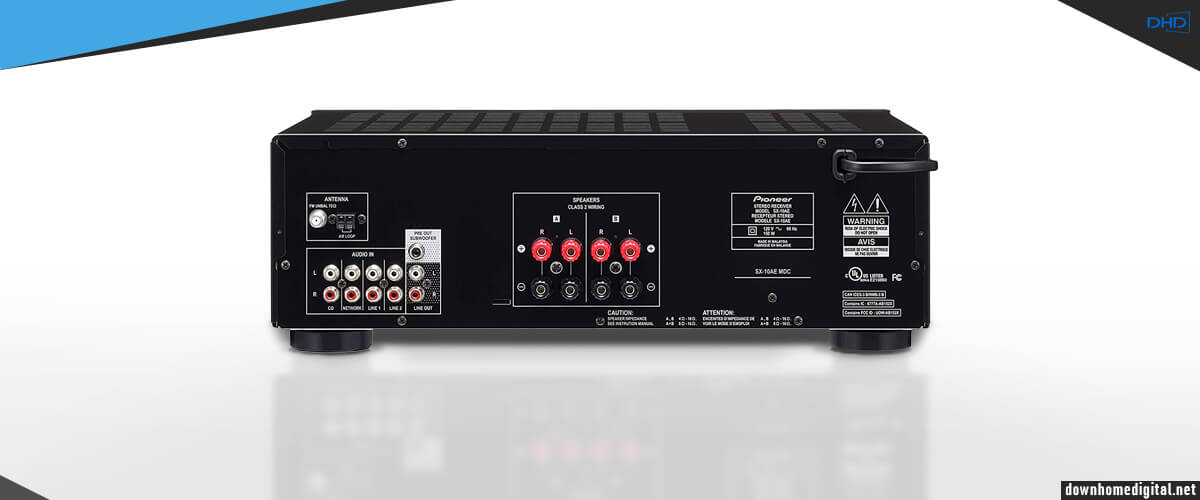
I want to say that the receiver corresponds to the equipment for its narrow purpose. The rear panel houses four pairs of tulips of the aforementioned inputs and a line-out. Looking ahead, I will say that it turned out to be unregulated, in which case it will not work to use the SX-10AE in conjunction with an external power amplifier. There are two pairs of speaker terminals, and you can connect speakers to both of them simultaneously. It costs so little that there is simply no desire to cling to its design. Usually, the only thing I expect from equipment of this level is that it should fulfill its stated functions. But the two-channel stereo receiver is quite nice, although the volume control scrolls too easily. It’s good that you can squeeze a little volume out of it.
Moving on to the test, I want to say that with a power of 45 watts per channel with an impedance of 8 ohms, the SX-10AE produces a vigorous, truly dynamic sound in which you can feel both the plastic and the quite correct organization of the sound stage.
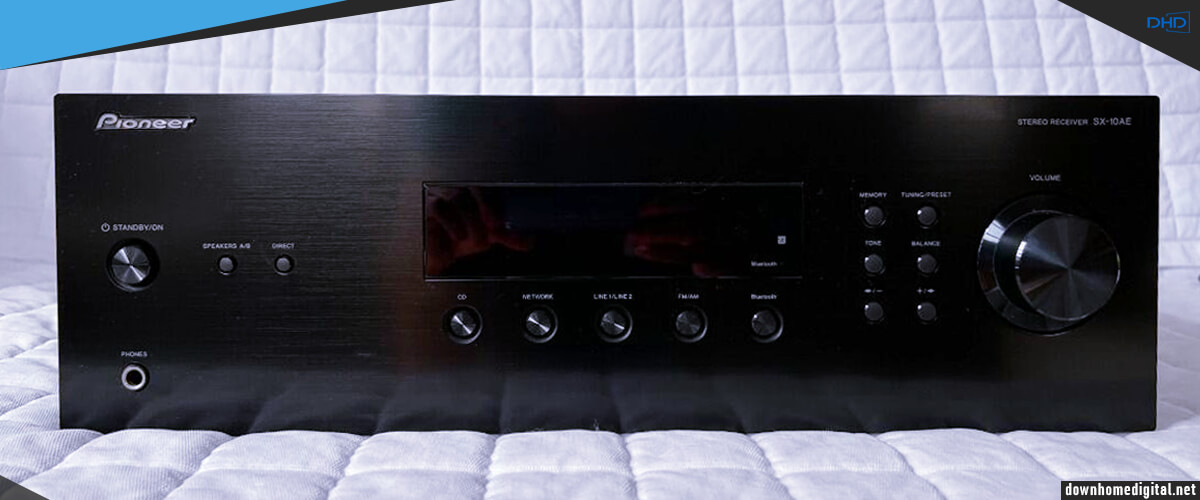
Regardless of the source, I got a harmonious and fairly balanced sound from the receiver. Let it not have a too high resolution at HF and not limitless bass dynamics corresponding to the class, and there’s no crossover on the bass output, but it is embossed and comfortable for perception.
Pioneer SX-10AE is the best Pioneer stereo receiver for those who, for various reasons, do not want to spend a severe budget on the setup but, on the other hand, expect a relatively harmonious and, if possible, dynamic sound. Bluetooth streaming sound is smooth and smooth, so think of this device as an amplifier for your phone that will fill a small room with clear enough sound. With the ability to connect good speakers and an external source, you’ll get more than just a regular boombox.
| Power |
|
| HDMI features |
|
| Video features |
|
| Network |
|
| Surround sound processing |
|
Pros
- Excellent value for that money.
- The sound for Bluetooth streaming goes without delays or interference.
Cons
- Small power 45 watts per channel.
- No crossover on subwoofer output.
Pioneer VSX-935
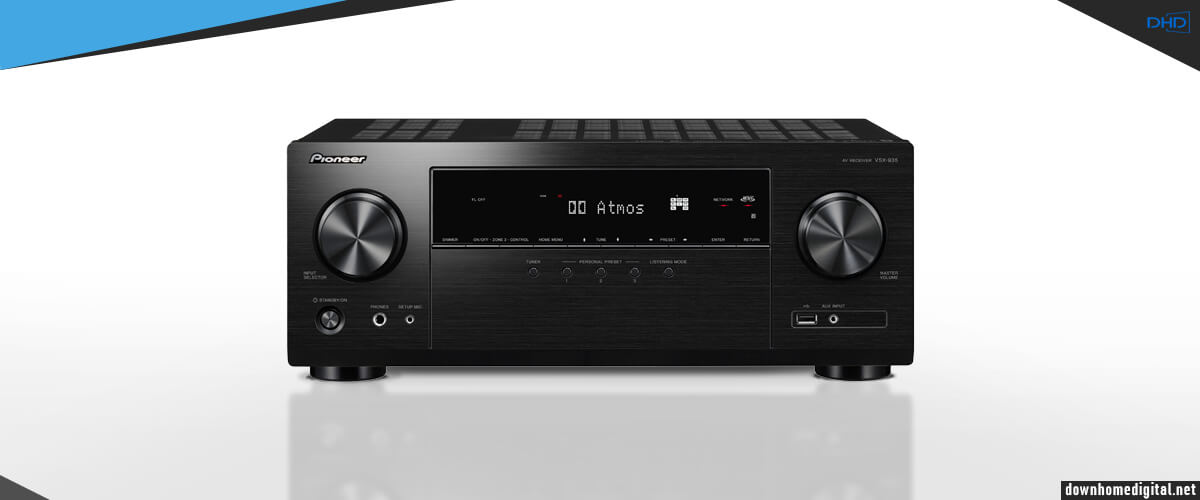
Pioneer VSX-935 is a mid-range 7.2-channel receiver, which can be transformed into a 5.1.2 Atmos/DTS-X setup. Each channel delivers 80W of power at 8 Ohms with THD 0.08% and 170W at 6 Ohms, which is more than enough for you to enjoy a distortion-free sound from your home speakers. In my review, it could be considered as a cheaper alternative to the Pioneer Elite VSX-LX105.
The receiver is made in the brand’s traditions and has a rather large screen, but not as bright as the Elite series. The design is somewhat inferior to the more expensive version in reliability. It feels like thinner metal, which sags under the hands. There is a lot of plastic, and the control buttons are too small. Regulators a little “walk,” it feels like they will stay in hand at a certain moment, but I think it’s just a feeling. I like that the front panel has USB and 3.5mm stereo mini-jack ports for easier access. It’s important to note that while the receiver is not insignificant in size, the ventilation is not very well thought out, and it overheats when running for long periods.

This model has six HDMI inputs and two outputs. The same as the VSX-LX105, and with the same features: 3 8K inputs and 3 4K inputs. You can also use two digital audio inputs (one optical and coaxial). The receiver supports 8K60 and 4K120 as well as HDR10+, HDR10, and HLG Dynamic HDR. Video transmission satisfied me, but like VSX-LX105, upscaling up to 8K is rather a nominal function because, in fact, the receiver does not cope with the task, and I often saw pixels on the screen instead of a full image. But this is normal for its price.
My favorite part about this device is its optimization for gaming. The VSX-935 model features 4K/120Hz HDR pass-through for ultra-fast motion. With the ALLM (Auto Low Latency Mode), I easily optimized latency from my console to screen, while QFT (Quick Frame Transport) limited lags for a smoother gaming experience.

The built-in 5 GHz/2.4 GHz Wi-Fi and Bluetooth make using the receiver more convenient and versatile. Another bonus is compatibility with major streaming technologies (Sonos, Chromecast, AirPlay 2, and DTS Play-Fi) and services (Spotify, Amazon Music, Pandora, TIDAL, and Deezer). Note that when you stream music through built-in applications, the sound is significantly better than when connected via Bluetooth. If you prefer voice assistants, you’ll be happy to know that this receiver supports Google Assistant and Amazon Alexa.
VSX-935 sounds pretty good for its category. It accomplishes its main task: amplifying sound and distributing it to 7 channels for watching movies with surround sound. It’s not supernatural sounding; it’s even simpler than the VSX-LX105. It also lacks the power to fill a room over 200 square feet. The sound scatters and loses balance in a larger room, so you can’t hear part of the big picture from the corners. But it’s pretty clean, though flat, like most Pioneer models. Let’s say it lacks some expressiveness, though I didn’t notice any major lapses in clarity. In some scenes, you have to adjust the sound to hear what’s happening on the screen.
Pioneer VSX-935 will give you Dolby Atmos surround sound, the ability to watch 8K video, quality console gaming, and good-quality music playback. But, like all inexpensive receivers, it has its drawbacks. The power isn’t enough for more than 200 square feet, the 8K video enhancement feature doesn’t work properly, and the Bluetooth is unstable. But the picture becomes more balanced when you consider its price and overall working conditions. Everything is in moderation. Decent quality for its money.
For a 7-channel device, the Pioneer VSX-935 is quite good, but it loses compared with the Pioneer Elite VSX-LX105. Paying just a couple hundred more will get you a more stable unit, from the quality of the cabinet to a fuller sound picture.
| Power |
|
| HDMI features |
|
| Video features |
|
| Network |
|
| Surround sound processing |
|
Pros
- Audio and video capabilities match the more expensive VSX-LX105.
- Suitable for movies, games, and music.
Cons
- Power is less than the more expensive VSX-LX105.
- Not as robust as the VSX-LX105.
- Possible degradation of sound quality when streaming via Bluetooth.
- Inferior to the VSX-LX105 in overall sound sideband, as it is only suitable for small rooms.
- Overheats during prolonged operation.
Buyer’s guide

How many channels do I need?
Home theater systems now come in a variety of sizes and combinations. The most common 5.1 systems with five speakers and a subwoofer. As an extension, the very popular 7.1 with two additional surround speakers. Dolby Atmos and other formats with additional ceiling speakers have been gaining popularity for several years now.
The classic choice when setting up your first home theater system is 5.1. Here, 5.1 stands for five speakers providing all-around sound and a subwoofer that fills the room with deep bass. However, if you want to keep up with the times and hear a 3D sound, that is, additional sound from above, you need a system of at least 5.1.2. Two on the specifications means an extra two overhead speakers. Here, I need a receiver that offers 7.1 channels. If, for example, a 5.1 system already exists, you can leave it as it is and update it with two overhead speakers and a suitable AV receiver.
How much power per channel do I need?
This is the amount of power the amplifier will send to the speakers and can range from 30W to 500W. Here, it is worth noting that it is customary to specify the so-called RMS (Rated Maximum Sinusoidal) or rated power in this case. The rated power is the highest power that the amplifier is guaranteed to deliver without interruption for an hour without any malfunction or breakdown.
The power of the amplifier largely determines the volume of the loudspeaker connected to the unit. The volume also depends on the characteristics of the speakers – sensitivity, impedance, etc. All other things being equal, the same speakers will sound louder with a more powerful amplifier. In addition, this parameter also affects the compatibility of speakers and amplifiers – it is considered that the difference in the rated power of these components should not exceed 10-15% (and ideally, the power should coincide at all).
And since different rooms require different wattages, this also affects the choice of a surround sound receiver for a particular environment; specific recommendations on the ratio of room characteristics and speaker power can be found in particular sources.
Pay attention to your connections
HDMI
The most important terminal today that a receiver must be equipped with is HDMI. But their number in your receiver should be determined by your needs. If you have a lot of audio and video equipment in your home, six inputs might be enough, while three HDMI inputs might be enough for other users.
However, remember, the abundance of ports increases the cost of the equipment, so it is better to know in advance how many pieces of equipment you are going to use before you splurge. But on the other hand: a receiver will last a long time. Over the years, you will probably upgrade your system with new devices, many of which will require a separate HDMI port.
Other wired terminals
For audio devices without HDMI connections, such as a CD player, RCA or optical digital connections are best. If you have a turntable, you should consider having a phono output on your receiver. Or you can add a phono preamp to any receiver that lacks a phono input. Some turntables have built-in phono preamps.
Wireless connections
Wi-Fi and Bluetooth have already become mandatory technologies for most classes of receivers. Bluetooth streaming lets you send audio from your phone or tablet to your receiver for playback on your surround speakers. On the other hand, connecting the receiver to your home Wi-Fi network means you can play music or video from any device connected to it, such as your PC.
AirPlay
Another great option is AirPlay. It is similar in purpose to Bluetooth. It is also used for wireless music streaming. Broadcasting takes place via Wi-Fi and has a reasonably high quality. And if the receiver is compatible with the AAC codec, the sound will be very high. However, this feature will only be helpful for owners of Apple devices.
Streaming Services
Many receivers can be connected to your home network and also provide direct playback of music from Internet services such as Pandora, Spotify, Deezer and various Internet radio portals. You can also play music and sounds directly from your computer or network hard drive.
What is multi-room audio and do I need it
One of the advantages of 7.1-channel receivers is the presence of two additional channels that can be used for sounding another room. Most of these receivers can even broadcast different audio sources to two rooms.
However, not everything is so universal. Most receivers cannot pass any digital input source (HDMI and digital audio input) to the second zone. Finally, remember that you probably won’t be able to control the second source from the remote.
Thus, even if you think you need a second audio zone feature, make sure you are aware of all the restrictions. It is easier to install trim, separate audio systems (or Bluetooth speakers) in the second room in many cases. This wireless multi-room can be organized thanks to the technologies of Sonos, HEOS, Music Cast, and many others.



